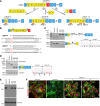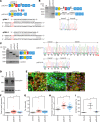Functional correction of dystrophin actin binding domain mutations by genome editing
- PMID: 28931764
- PMCID: PMC5621913
- DOI: 10.1172/jci.insight.95918
Functional correction of dystrophin actin binding domain mutations by genome editing
Abstract
Dystrophin maintains the integrity of striated muscles by linking the actin cytoskeleton with the cell membrane. Duchenne muscular dystrophy (DMD) is caused by mutations in the dystrophin gene (DMD) that result in progressive, debilitating muscle weakness, cardiomyopathy, and a shortened lifespan. Mutations of dystrophin that disrupt the amino-terminal actin-binding domain 1 (ABD-1), encoded by exons 2-8, represent the second-most common cause of DMD. In the present study, we compared three different strategies for CRISPR/Cas9 genome editing to correct mutations in the ABD-1 region of the DMD gene by deleting exons 3-9, 6-9, or 7-11 in human induced pluripotent stem cells (iPSCs) and by assessing the function of iPSC-derived cardiomyocytes. All three exon deletion strategies enabled the expression of truncated dystrophin protein and restoration of cardiomyocyte contractility and calcium transients to varying degrees. We show that deletion of exons 3-9 by genomic editing provides an especially effective means of correcting disease-causing ABD-1 mutations. These findings represent an important step toward eventual correction of common DMD mutations and provide a means of rapidly assessing the expression and function of internally truncated forms of dystrophin-lacking portions of ABD-1.
Keywords: Gene therapy; Genetic diseases; Muscle; Muscle Biology.
Conflict of interest statement
Figures






References
Publication types
MeSH terms
Substances
Grants and funding
LinkOut - more resources
Full Text Sources
Other Literature Sources
Research Materials

